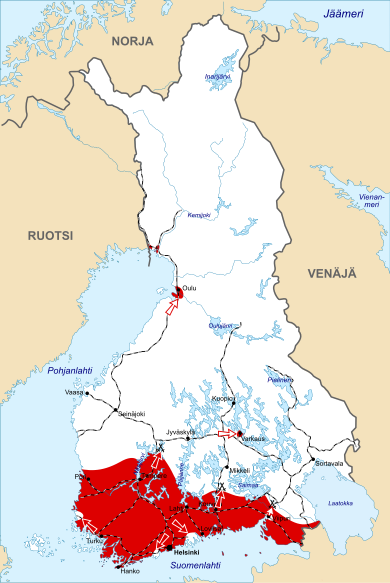Finnish Socialist Workers' Republic
The Finnish Socialist Workers' Republic (FSWR), more commonly referred to as Red Finland, was a theoretical precursor of a Finnish socialist state. It was outlined during the Finnish Civil War, on 29 January 1918 by the Finnish People's Delegation, the Reds and Red Guards of the Finnish Social Democratic Party, after the socialist revolution in Finland on 26 January 1918.
Finnish Socialist Workers' Republic Suomen sosialistinen työväentasavalta Finlands socialistiska arbetarrepublik | |||||||||
|---|---|---|---|---|---|---|---|---|---|
| 1918–1918 | |||||||||
 Red: Red Finland White: White Finland | |||||||||
| Capital | Helsinki | ||||||||
| Common languages | Finnish, Swedish | ||||||||
| Government | Precursor of a Socialist state | ||||||||
| Chairman | |||||||||
| Legislature | Finnish People's Delegation | ||||||||
| Historical era | World War I and Finnish Civil War | ||||||||
• Established | 29 January 1918 | ||||||||
• Disestablished | 5 May 1918 | ||||||||
| Currency | Markka | ||||||||
| |||||||||
| Today part of | |||||||||
The name "Finnish Socialist Workers' Republic" (Suomen sosialistinen työväentasavalta) appeared only in the Treaty between Finnish People's Delegation and Russian Council of People's Commissars, signed 1 March 1918. The People's Delegation had earlier used the name Republic of Finland (Suomen tasavalta), but Soviet leader V. I. Lenin proposed adding the attributes "Socialist Workers' Republic" into the name during negotiations. The People's Delegation later blamed its delegates for succumbing to Lenin's demand, since the official name of the state should have been decided by the Finns themselves.
Aims
Red Finland/FSWR was an attempt to establish a socialist nation, based on the legacy of Scandinavian-Finnish culture, socialist ideas originating from Central Europe and Finnish nationalism, including plans to expand the Finnish territory. The political visions included principles of democracy, but as Red Finland was primarily the formation of revolution and civil war, the acts of violence and warfare were emphasized in the policy. The Red Guards included a minor faction of Finnish Bolsheviks who supported association of FSWR to Soviet Russia. FSWR/Red Finland never gained a true status and form of state and republic as the Reds lost the Civil War on 5 May 1918.[1]
Geographical area
The geographical area of Red Finland as well as the front line between White and Red Finland took shape approximately between 28 January and 3 February 1918, and it remained largely unchanged until the general offensive of the Whites in March 1918.[2]
Draft constitution
The Finnish People's Delegation, mainly Otto Ville Kuusinen, formulated and set forth, on 23 February 1918, a draft for a constitution of Red Finland/FSWR, on the basis of the Finnish Social Democratic principles and mentality. The Marxist concept of dictatorship of the proletariat was absent from the program. Instead, it represented an idea of democratic socialism and it was influenced by the constitutions of Switzerland and United States, and French Revolution. The constitution model included most of democratic civil rights for the Finnish citizens, including an extensive use of referendum in political decision making, but private property rights were excluded and given to state and local administration. The draft was never finally formulated and approved in Red Finland, before the defeat of FSWR in the 1918 war.[3]
The power political situation after the January Revolution in Finland raised a major question in terms of the constitution draft, among the Finnish (moderate) socialists: would the power gained via revolution allow democracy a true chance in Finnish society? Finally, political terror, carried out by the Red Guards during the Finnish civil war, led to marked controversy between the principles of democracy and the situation in the country.[4]
Relations with Lenin
Although the Finnish Socialist Worker's Republic was supported by the Russian Soviet Federative Socialist Republic (RSFSR), led by Vladimir Lenin, and the 1 March 1918 Red Treaty was signed between these two unstable socialist states, an ideal level of co-operation and co-ordination was never achieved, due to both states being preoccupied with their own respective civil wars. The goal of the Finnish Reds' majority was a neutral and independent Finland, and some of them demanded annexation of Aunus, Viena Karelia and Petsamo areas of Russian Karelia to Finland. The Russian-Finnish Red treaty had only minor importance for the Bolsheviks as they carried out peace negotiations with the German Empire. In the end, the fate of the Finnish Reds and FSWR was determined through the power political decisions made between Russia and Germany.[5]
Lenin aimed to halt a complete collapse of Russia after the revolutionary year 1917. While in political opposition prior to the October Revolution, Lenin emphasized the policy of nations' right to self-determination for the former parts of the Russian Empire. After the successful seizure of power in October 1917 and in January 1918, the Bolsheviks' power political strategy shifted gradually toward federalism. As for Finland, Lenin plotted its annexation by Russia, but the Russian Civil War, German-Russian Treaty of Brest-Litovsk, Finland-operation of the German Army, the victory of the White Guards in the Finnish civil war and the marked nationalism among the Finnish socialists stalled his plan.[6]
Civil war
The warfare between the Reds and Whites took major attention and energy of the Red leadership. Therefore, formation of the local Red civil administration remained unfinished and waited for the result of the Civil War. The top and middle-rank civil servants of the pre-civil war administration refused to co-operate with the Reds, and a new leadership had to be chosen and trained from the lower rank servants.[7]
Defeat of the FSWR
The Finnish Civil War ended with the German invasion of Finland and the consequent defeat of the Finnish Red Guards and FSWR on 5 May 1918. After the war, the initially powerful and well-organized Finnish Social Democrats, born and bred in the relatively free and nationalistic social atmosphere, within the Scandinavian and Russian culture, and affected primarily by socialist ideas of Germany, Austria and Czechoslovakia (pre-World War I Austria-Hungary), were split in two. The moderate socialists continued their pre-1918 political culture, adhered to the society and political system of Finland, while the far-left faction formed the Communist Party of Finland in August 1918 in Moscow, with the main leaders living in exile in Russia and a marked part of the common supporters living in Finland.[8]
See also
- Republic of Finland
- Finnish Democratic Republic — short-lived Soviet puppet government during World War II
- Karelo-Finnish Soviet Socialist Republic
- Kingdom of Finland (1918)
- Revolutions of 1917–23
- Santeri Nuorteva
Citations and notes
- Rinta-Tassi 1986, pp. 73–113, 417–429, Klemettilä 1989, pp. 163–203, Keränen et al. 1992, pp. 88, 106, Pietiäinen 1992, pp. 252–403, Manninen 1995, pp. 21–32, Jussila 2007, pp. 287–288, Jyränki 2014, pp. 10–16
- Keränen et al. 1992, pp. 88–90
- Upton 1973, pp. 105–142, Rinta-Tassi 1986, pp. 19–24, 30–33, 497–504, Alapuro 1988, pp. 167–176, Keränen et al. 1992, pp. 88, 102, Piilonen 1993, pp. 486–627, Jussila 2007, pp. 287–288, Suodenjoki 2009, pp. 249–269, Payne 2011, pp. 25–32
- The relation between democracy and revolution was contradictory for the socialists, as the February revolution empowered the lamed Finnish Parliament, until July 1917; restoration of the socialists' power in the Parliament was among the main goals of the January Revolution 1918. The Finnish Red-White conflict of 1918 has been described as Class War, Rebellion, (Red) Revolt and Abortive (Red) Revolution by the Finnish Red veterans, Kettunen 1986, pp. 9–89, Rinta-Tassi 1986, pp. 497–504, Piilonen 1993, pp. 486–627, Kalela 2008, pp. 31–44
- Edvard Gylling was the prime mover at the start of the Finnish-Russian talks for the Red Treaty; among other things he aimed to work for peace talks between the Finnish Whites and Reds, by diminishing the Russian influence in Finland. The Finnish Bolsheviks, few in number, but influential and active in the Finnish Red Guards supported Lenin's Russian federalism. The Finns got Petsamo, but the question of Aunus and Viena remained open, Upton 1981, pp. 262–265, Rinta-Tassi 1986, pp. 417–429, Klemettilä 1989, pp. 163–203, Keränen et al. 1992, pp. 106, Pietiäinen 1992, pp. 252–403, Piilonen 1993, pp. 486–627, Manninen 1995, pp. 21–32, Jussila 2007, pp. 287–288, Jyränki 2014, pp. 83–96
- In fact, Lenin's "socialist" power policy followed that of the former Romanov empire; the geopolitical position of a country determined the way it was treated by the Russian leadership (e.g. Poland-Ukraine vs. Finland), Rinta-Tassi 1986, pp. 24–28, Klemettilä 1989, pp. 163–203, Pipes 1996, pp. 382–406, Jussila 2007, pp. 282–288
- Piilonen 1993, pp. 486–627, Suodenjoki 2009, pp. 249–269
- Rinta-Tassi 1986, pp. 19–22, 497–504, Jussila 2007, pp. 287–288, Haapala 2014, pp. 21–50
References
- Alapuro, Risto (1988), State and Revolution in Finland, University of California Press, Berkeley, ISBN 0-520-05813-5.
- Haapala, Pertti (2014), "The Expected and Non-Expected Roots of Chaos: Preconditions of the Finnish Civil War", in Tepora, T.; Roselius, A. (eds.), The Finnish Civil War 1918. History, Memory, Legacy, Brill Academic Press, pp. 21–50, ISBN 978-900-4243-66-8.
- Jussila, Osmo (2007), Suomen historian suuret myytit (in Finnish), WSOY, ISBN 978-951-0-33103-3.
- Jyränki, Antero (2014), Kansa kahtia, henki halpaa. Oikeus sisällissodan Suomessa? (in Finnish), ISBN 978-951-884-520-4.
- Kalela, Jorma (2008), "Yhteiskunnallinen kysymys ja porvarillinen reformismi", in Pernaa, V.; Niemi, K. Mari (eds.), Suomalaisen yhteiskunnan poliittinen historia (in Finnish), pp. 31–44, ISBN 978-951-37-5321-4.
- Keränen, Jorma; Tiainen, Jorma; Ahola, Matti; Ahola, Veikko; Frey, Stina; Lempinen, Jorma; Ojanen, Eero; Paakkonen, Jari; Talja, Virpi; Väänänen, Juha (1992), Suomen itsenäistymisen kronikka (in Finnish), Gummerus, ISBN 951-20-3800-5.
- Kettunen, Pauli (1986), Poliittinen liike ja sosiaalinen kollektiivisuus: tutkimus sosialidemokratiasta ja ammattiyhdistysliikkeestä Suomessa 1918-1930, Historiallisia tutkimuksia (in Finnish), Jyväskylä: Gummerus, ISBN 951-9254-86-2.
- Klemettilä, Aimo (1989), "Lenin ja Suomen kansalaissota", in Numminen, J.; Apunen, O.; von Gerich-Porkkala, C.; Jungar, S.; Paloposki, T.; Kallio, V.; Kuusi, H.; Jokela, P.; Veilahti, V. (eds.), Lenin ja Suomi II (in Finnish), pp. 163–203, ISBN 951-860-402-9.
- Manninen, Ohto (1995), "Vapaussota - osana suursotaa ja Venäjän imperiumin hajoamista", in Aunesluoma, J.; Häikiö, M. (eds.), Suomen vapaussota 1918. Kartasto ja tutkimusopas (in Finnish), pp. 21–32, ISBN 951-0-20174-X.
- Payne, Stanley G. (2011), Civil War in Europe, 1905-1949, Cambridge University Press, ISBN 978-1-107-64815-9.
- Pietiäinen, Jukka-Pekka (1992), "Suomen ulkopolitiikan alku", in Manninen, O. (ed.), Itsenäistymisen vuodet 1917–1920, III Katse tulevaisuuteen (in Finnish), pp. 252–403, ISBN 951-37-0729-6.
- Piilonen, Juhani (1993), "Rintamien selustassa", in Manninen, O. (ed.), Itsenäistymisen vuodet 1917-1920, II Taistelu vallasta (in Finnish), pp. 486–627, ISBN 951-37-0728-8.
- Pipes, Richard (1996), A Concise History of the Russian Revolution, ISBN 0-679-74544-0.
- Rinta-Tassi, Osmo (1986), Kansanvaltuuskunta Punaisen Suomen hallituksena (in Finnish), Opetusministeriö, ISBN 951-860-079-1.
- Suodenjoki, Sami (2009), "Siviilihallinto", in Haapala, P.; Hoppu, T. (eds.), Sisällissodan pikkujättiläinen (in Finnish), pp. 246–269, ISBN 978-951-0-35452-0.
- Upton, Anthony F. (1973), The Communist Parties of Scandinavia and Finlan, London: Weidenfeld & Nicolson, ISBN 0-297-99542-1.
- Upton, Anthony F. (1981), Vallankumous Suomessa 1917-1918, II (in Finnish), Gummerus Oy, ISBN 951-26-2022-7.
External links
- Treaty of Friendship with the Finnish Socialist Workers’ Republic, a Russian-Finnish treaty.
- Treaty with the Finnish Socialist Workers’ Republic, Lenin's writings on the matter.

